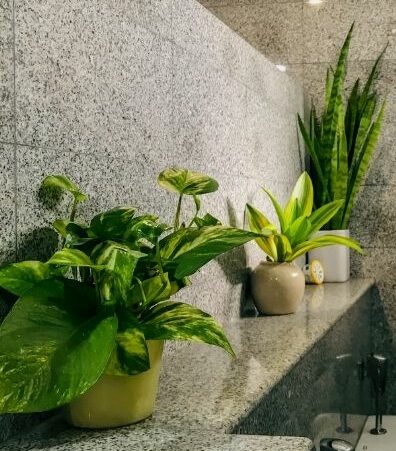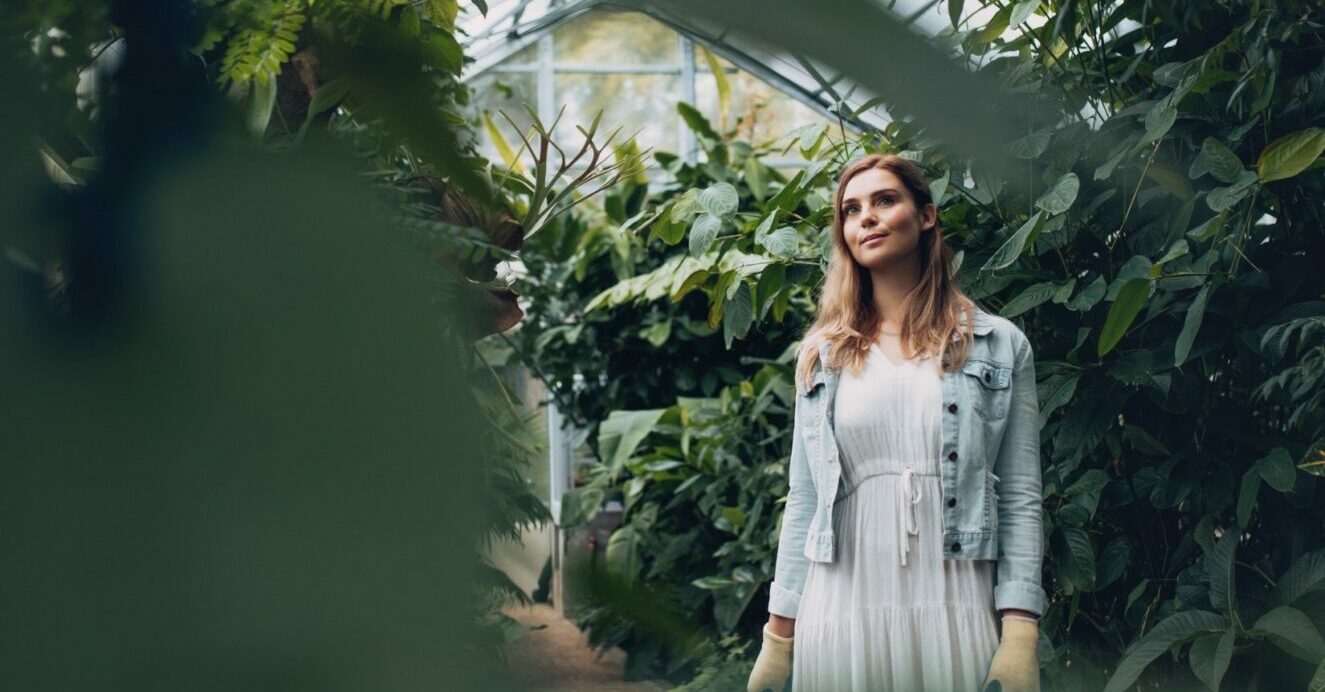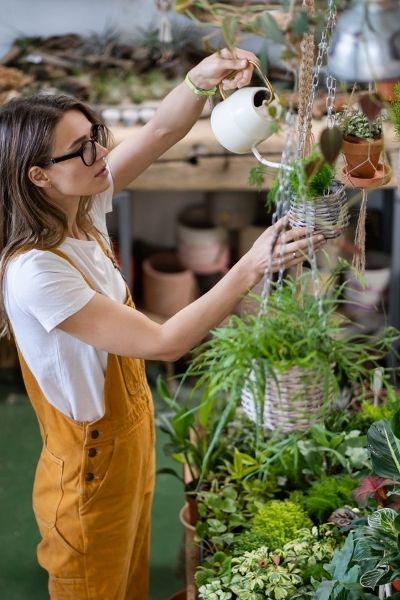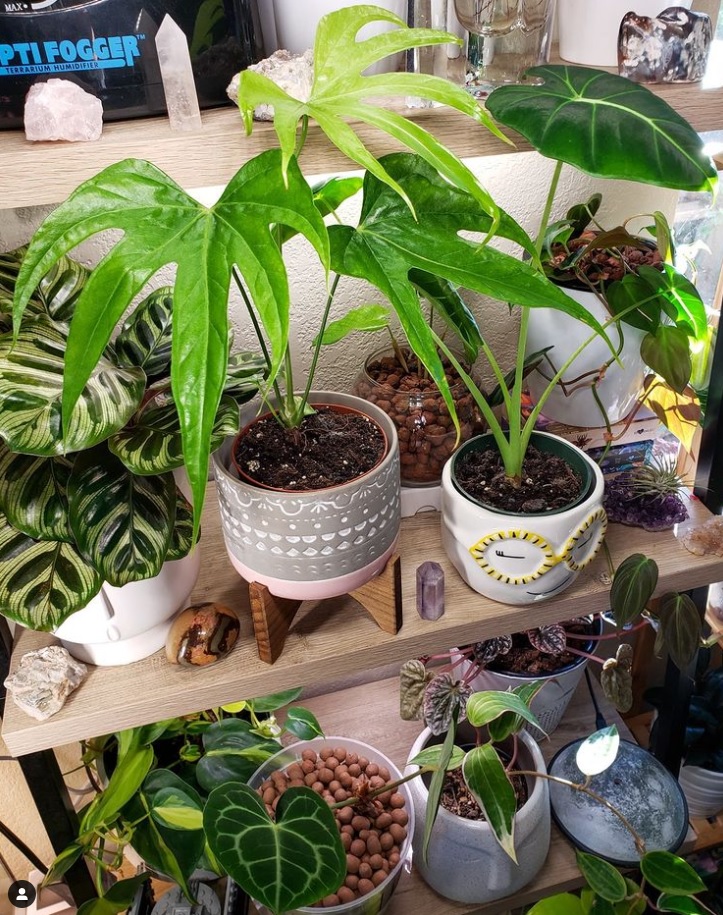At Patuxent Nursery we have the privilege of watching plants grow; it isn’t often we get to see a whole new career field grow and take root right before our eyes. Our indoor plant collection has grown significantly in the past year to meet the increase in demand in our industry. Many new plant parents were born from nearly two years of quarantine. While so many people are falling in love with indoor plants, we’ve also seen a new group grow in numbers: plant stylists.
A plant stylist is more than just your knowledgeable neighbor with a green thumb. While this career has really become a way to make a sustainable income, you cannot deny the finesse and skill these plant stylists bring to the table. If you’re looking for a new life calling, or you simply want to know how to style your own plants, read on. (Skip to the bottom for key tips and tricks!)
What is Plant Styling?
Plant styling is the art of assessing a space and then decorating it with plants that will look and live their best lives in a given space. A plant designer needs to read the room, literally, and choose plants that will thrive with what is available.
Plant stylists need an encyclopedic knowledge of different types of indoor plants. With this knowledge at their fingertips, they can get to know their client and see how much space, light, humidity, and style they are working with. Is it a dry and dark apartment with a plant newbie resident? That might need indestructible ZZ plants, Snake plants, and a few grow lights. A big bright sunny corner in a living room and a major plant enthusiast? Get them a Fiddle Leaf Fig! (And simply remind them to avoid moving it if it’s happy.)
Choosing the right containers is another major part of the job description. An interior designer can choose a great-looking pot, but would they necessarily know to avoid putting a fern in a terra-cotta pot if their client is prone to forget watering it regularly? Some decisions need the craftiness of a specialized expert.
 three plants on an industrial shelf part of plant styling
three plants on an industrial shelf part of plant styling
When choosing a plant stylist, you’ll find that there are many levels of involvement one may offer. Some stylists charge by the hour and can help a new homeowner start from scratch, helping them choose the best plants and teaching them how to take care of their new plant babies.
Others offer a range of services, including guidance for a space that already has plants but maybe not the right ones, weekly plant maintenance, or some emergency plant rescuing. They work with anyone from apartment dwellers to office managers, restaurateurs, and home staging companies. It’s an incredibly creative and fulfilling role, blending an appreciation for interior design and balance with a love for all things green.
Here are a few well known plant stylists if you want to see more of what these artists have to offer:

an experienced plant stylist assessing plants
How Does One Become A Plant Stylist?
In recent years, many green thumbs have taken their hobbies on the road and nurtured full-fledged careers as plant stylists and we don’t see the niche dying down anytime soon. If you think you have what it takes here are some steps to help you get a head start.
Get Styling
Just remember, everyone has to start somewhere and as with any hobby, it is important to practice, practice, practice!
- – Practice plant styling your own home to make your greenery shine and reach out to a few friends who will let you do the same in their spaces.
- – Practice playing with containers, plant sizes, leaf shape, and color and see how they change the room they’re in.
- – Practice matching trailing plants over shelves and mixing and matching different kinds of foliage together. Find out what brings a space to life for you, what are your go-to plant staples and what plant trends you think will work for future clients.
- – Practice the advice we have listed later in this article, and research which other plant stylists you like and what you like about them.
Being a great plant stylist, we think, starts with developing a sense of plant style.
 a young plant stylist learning how to style
a young plant stylist learning how to style
Get Social
Plant styling is a career based in freelancing, so networking is key. Take pictures of the creative ways you’ve staged your plants at home (or at friends’ homes), and share them on social media. Build a following so you can show your work to locals in your area. Reach out to neighborhood Facebook groups, interior designers, home staging companies, landscaping companies, realtors, and anyone whose life you could make easier by taking the plant styling part of their job off their hands. Once the referrals start to come in, you’ll be off to the plant styling races.
 phone user taking pictures of plants for plant styling portfolio
phone user taking pictures of plants for plant styling portfolio
Patuxent Nursery is here to help provide the indoor plants you need to succeed, from bread and butter easy-care plants to rare collectibles (for pickier, braver clients).

a young plant stylist with a phone
How Can I Style My Own Plants Myself?
Maybe the life of a professional plant stylist isn’t for you. That doesn’t mean you can’t bring the principles of plant styling into your own life. Read below for some tips from the experts that will help you up to your own plant styling game.
Read the Room
The first step is scheduling a consultation and doing a walk-through of the space. This is to look at where the light hits at certain parts of the day, how dry or humid the space is during most of the year, and what the client is looking for when it comes to plant difficulty. Do the same for yourself. Which rooms do you frequent the most? Look (and we can’t stress this enough) at how much light enters the room and where it lands.
Be honest with yourself on what level of care you’re interested in and how much time you have. Then, as you read about different kinds of plants, you can recall back to your assessment and know which plants will be happiest in your care. Read up on the mature sizes of plants so that you can know to match petite Frosty Ferns with a small space and wide-reaching hoyas with a shelf all to themselves.
 full version of eclectic living room with plants
full version of eclectic living room with plants
Play with Color and Shape
Now for the fun part! Once you know what the space offers, you can look for plants that will warm up spaces, soften corners, and add visual interest to your home. Add height to a room with a modern sense of style by adding tall Sansevierias installing a hook and hanging a basket with trailing Philodendron Brasil. Don’t be afraid to mix different leaf colors or shapes together for a visually attractive contrast.
Three rules of thumb we’ve come across when it comes to plant styling:
- – Design displays in odd numbers. This can be three plants together, or one cactus in a cute container and two pieces of art décor to match.
- – Less is more. Letting one distinct plant shine on a sunny windowsill can sometimes be more effective than five small ones grouped together.
- – Don’t forget to get creative with the containers! We recommend leaving houseplants in their nursery containers and placing that within a decorative one. This way you can change things around as you wish without shocking a plant unnecessarily. (Also, always use containers that withstand moisture, or line them in plastic first.)
 plants with lots of kinds of shapes
plants with lots of kinds of shapes
Invest in Quality Tools
After styling comes maintenance. If you’re newer to plant parenthood, we recommend getting started on the right foot with the right kinds of tools that will make your plant life easier. Feel free to ask our staff for their preferred indoor go-to tools and they can show you our latest and greatest. Here are some must-haves that will make your plant styling easy.
- -Good, Sharp Shears. You can get away with kitchen shears, but keep one pair dedicated to just plants and sanitize it before pruning your plants.
- – A Watering Can with a Long Spout. Most indoor plants don’t like it when their foliage stays wet, and it’s generally better to try and water them at the soil level when possible. This also prevents splashing water off of leaves and all over you or your sofa. Learn from us – a long spout will go a long way.
- – Organic Horticultural Oil. This is a great fix-all to treat and prevent indoor plant pests or fungi. Our staff can help you look through the different kinds we have to see which one is right for you, since some are stronger than others.
- – A Potting Tray and Small Trowel. Getting soil everywhere stinks. It’s easier to repot or add soil when you know you don’t have to then vacuum immediately after.
- – Fertilizer or Plant Food. Potted plants don’t have access to nutrients the same way garden plants do, and they can deplete the nutrients in their own soil after a while. If you don’t want to think about when you last fed your plants, a slow-release formula can make it easier to know your plants are getting everything they need. Not all plants have the same fertilizer requirements, so make sure to circle back and check what your plants need.
 plant stylist watering plants
plant stylist watering plants
 natashas nursery colorful pots with nursery pots in them
natashas nursery colorful pots with nursery pots in them
Here’s a great example of a plant shelfie that showcases a few of the things we’ve discussed. Instagram user @natashasnursery has mixed foliage with different colors and shapes, and they use nursery pots inside of their decorative pots. This way they can switch up their eclectic, playful pottery without having to repot the plants every time or drill holes for drainage.
After learning that plants can have some style too, are you ready to go rearrange your shelves? Or can you pat yourself on the back, knowing you have a natural knack for this kind of thing? Let us know!
We’re constantly bringing in new and exciting houseplants, so don’t forget to come and visit our showroom in Bowie, MD, for a little plant styling inspiration!

attractive plants on shelves
 plants on shelves
plants on shelves


Leave a Comment
You must be logged in to post a comment.